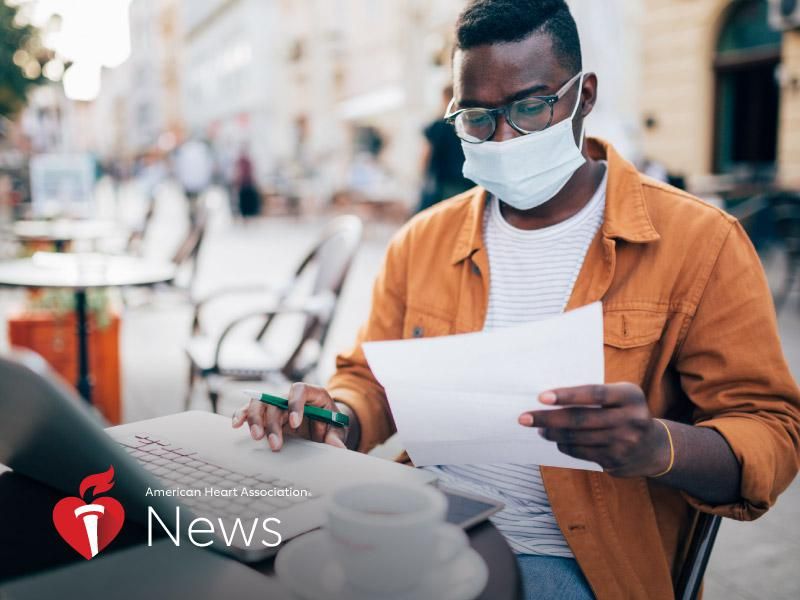MONDAY, March 8, 2021 (American Heart Association News) — As the COVID-19 pandemic persists, mental health professionals are growing more alarmed about a parallel mental health crisis brewing for young adults.
The burden of ongoing social, school and work restrictions, experts fear, is leading to a deterioration in the mental states of young adults who are increasingly worried about forfeiting precious time in their prime years, missing traditional milestones, and losing economic opportunities and vital relationships.
A Centers for Disease Control and Prevention report analyzing survey responses from 5,470 adults this past June revealed 1 in 4 respondents ages 18 to 24 had considered suicide within the past month and a similar number started or increased substance use because of the pandemic. About 75% of respondents in that age group also said they had one or more “adverse mental or behavioral health symptoms.” By comparison, among respondents 65 and older, 2% said they had considered suicide and 3% started or increased substance use. About 15% reported adverse mental health symptoms.
“The trends in mental health in young people have been going in the wrong direction, even before the pandemic,” said Laura D. Kubzansky, co-director of the Lee Kum Sheung Center for Health and Happiness at the Harvard T.H. Chan School of Public Health in Boston.
“We already knew they have been struggling more than previous generations,” she said. “But now in the pandemic, younger people also seem to be having a harder time with anxiety, depression, loneliness and so forth, especially those who live alone or are living in more transient circumstances due to schooling or other factors.”
According to an Active Minds Survey of 2,086 college students last April regarding the impact of the COVID-19 pandemic on their mental health, about 80% reported loneliness and isolation, disappointment and sadness, and stress and anxiety. And increased isolation as the year wore on only worsened the situation, according to an October report from the American Psychological Association. The hardest hit, the APA said, were Gen Z, young people 13 to 23 years old.
“Many students are away from their families and can’t go back because of rent issues or because they want to go to class, and it can be really hard to deal with at times,” said 28-year-old Dr. Ashima Dogra, who recently graduated from medical school and is president of the Boston University student group Express, Heal and Triumph.
“We need structure in our days and losing that can lead to feeling like life has no meaning,” said Dogra, who is studying for a master’s degree in public health. “People feel very lonely and depressed and anxious, and they don’t realize it can lead to an exacerbation of physical issues. I think that’s something that requires we take a step back and address our mental health, which is something younger people don’t take the time to do as much.”
Dogra learned about the important connection between the mind and body in 2018 when she was diagnosed with postural orthostatic tachycardia syndrome, or POTS. It’s a condition that affects blood flow, and it caused her to suffer from panic attacks for the first time in her life. With the help of her father, who has been meditating for 25 years, Dogra changed her diet, lifestyle and began her own yoga breathing and meditation practice.
“I noticed that whenever I would be stressed or anxious, I felt dizzy or clammy, and I would not digest easily,” she said. “But if I was focused on something else, like a project or being out with my family, it would disappear.
“A lot of young people have so much anxiety from social media, from being on their laptop all day for assignments or whatever, to what their friends are saying about them, to what’s happening in the world, all of it adds up to chronic daily stressors and that can definitely impact your overall health.”
While meditation and breathing exercises are effective calming techniques at times of high stress, Dogra said young adults also could benefit from reducing their time on social media, engaging in safe outdoor activities, and staying in touch with friends and family.
She recently led a group of students on a Zoom laughter therapy session. At first, everyone fake laughed together until it became real laughter. “After a while of fake laughing, it starts to feel real and the same amount of dopamine is released and it does help. Then we played a little music and danced a little.”
Kubzansky agrees that finding ways to stay connected and be active in nature can help boost morale for anyone. But she warns it’s important for clinicians to be mindful of a person’s social, organizational and community structures when considering how someone might cope with the pandemic or be able to solve a problem during the crisis.
“Mental health is a significant component of helping people to have better physical health, and certainly better heart health,” Kubzansky said. “It’s very strongly associated, but I want to make sure that we understand that people live in a larger social context and have a physical context too, and it’s going to be really important to understand how these environments enable or get in the way of achieving better mental health.”
American Heart Association News covers heart and brain health. Not all views expressed in this story reflect the official position of the American Heart Association. Copyright is owned or held by the American Heart Association, Inc., and all rights are reserved. If you have questions or comments about this story, please email editor@heart.org.
By Maria Elena Fernandez
Copyright © 2025 HealthDay. All rights reserved.

